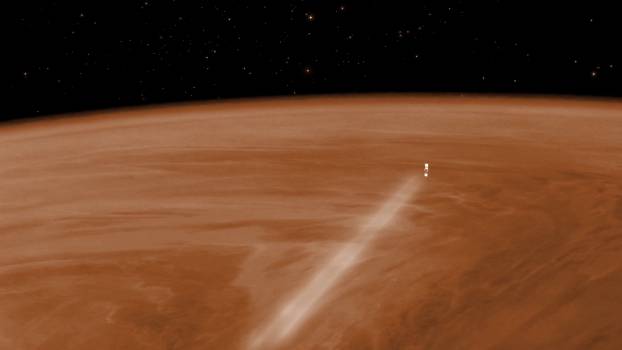Aerobraking results from Venus Express

November 12th, 2014
The first results from Venus Express were presented today at the DPS Planetary Sciences conference in Tucson Arizona.
The presentation is authored by ESA's Hakan Svedhem (Venus Express Project Scientist) and Imperial College's Ingo Mueller-Wodarg, who is leading the atmospheric density data analysis from this campaign.
Here is the text of the abstract, reproduced from the DPS website:
After a very successful mission orbiting Venus for more than 8 years, slowly the fuel is running out and the spacecraft will inevitably one day end up in the hot and acid atmosphere of the planet. Being near the end of the mission and in a position to accept some risk to the spacecraft we decided to take the opportunity to dip down deep into the atmosphere, to around 130 km, in a controlled manner, in order to make detailed in situ investigations of this for remote sensing instruments difficult to access region. The on board accelerometers gave direct measurements of the deceleration which in turn is directly proportional to the local atmospheric density. This provided an excellent way to study both the total density profile throughout the orbital arc in the atmosphere and small scale density variations in the region of the pericentre. The spacecraft behaved perfectly well throughout the whole campaign and provided a wealth of data both on the atmosphere and on the response of the spacecraft to the harsh environment with strong heat loads and some dynamic stress. At the time of the campaign the pericentre was located near the terminator at about 75 degrees Northern latitude. Aerobraking is a very efficient method of reducing the pericentre velocity and thereby reducing the apocentre altitude and the orbital period.
The so called "walk‐in" phase started at an altitude of 190 km on 17 May and the campaign ended on 11 July, after having reached a lowest altitude of 129.2 km. Subsequently, a series of orbit control manoeuvres lifted up the pericentre to 460 km altitude and the science activities were resumed after a thorough check‐out of the spacecraft. We have detected a highly variable atmosphere, both on a day to day basis and within the individual pericentre passes. The duration of each pass was approximately 100 s and the maximum dynamic pressure achieved was more than 0.75 N/m2, probably a record for a spacecraft that continued its operation afterwards. The orbital period was reduced over the duration of the campaign changing from 24 hours to 22 hours 20 minutes.
More information is also available in this story at the ESA website sci.esa.int
The presentation is authored by ESA's Hakan Svedhem (Venus Express Project Scientist) and Imperial College's Ingo Mueller-Wodarg, who is leading the atmospheric density data analysis from this campaign.
Here is the text of the abstract, reproduced from the DPS website:
After a very successful mission orbiting Venus for more than 8 years, slowly the fuel is running out and the spacecraft will inevitably one day end up in the hot and acid atmosphere of the planet. Being near the end of the mission and in a position to accept some risk to the spacecraft we decided to take the opportunity to dip down deep into the atmosphere, to around 130 km, in a controlled manner, in order to make detailed in situ investigations of this for remote sensing instruments difficult to access region. The on board accelerometers gave direct measurements of the deceleration which in turn is directly proportional to the local atmospheric density. This provided an excellent way to study both the total density profile throughout the orbital arc in the atmosphere and small scale density variations in the region of the pericentre. The spacecraft behaved perfectly well throughout the whole campaign and provided a wealth of data both on the atmosphere and on the response of the spacecraft to the harsh environment with strong heat loads and some dynamic stress. At the time of the campaign the pericentre was located near the terminator at about 75 degrees Northern latitude. Aerobraking is a very efficient method of reducing the pericentre velocity and thereby reducing the apocentre altitude and the orbital period.
The so called "walk‐in" phase started at an altitude of 190 km on 17 May and the campaign ended on 11 July, after having reached a lowest altitude of 129.2 km. Subsequently, a series of orbit control manoeuvres lifted up the pericentre to 460 km altitude and the science activities were resumed after a thorough check‐out of the spacecraft. We have detected a highly variable atmosphere, both on a day to day basis and within the individual pericentre passes. The duration of each pass was approximately 100 s and the maximum dynamic pressure achieved was more than 0.75 N/m2, probably a record for a spacecraft that continued its operation afterwards. The orbital period was reduced over the duration of the campaign changing from 24 hours to 22 hours 20 minutes.
More information is also available in this story at the ESA website sci.esa.int

